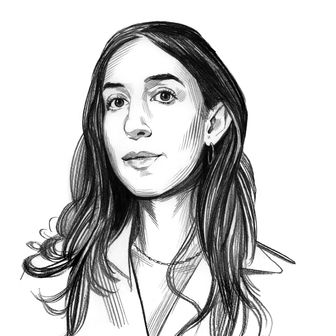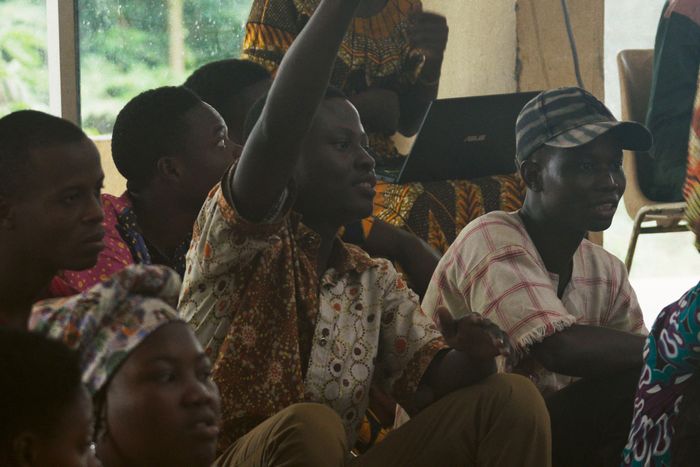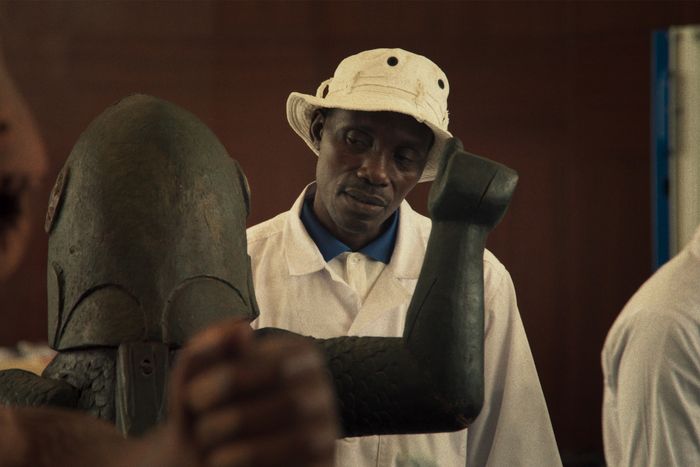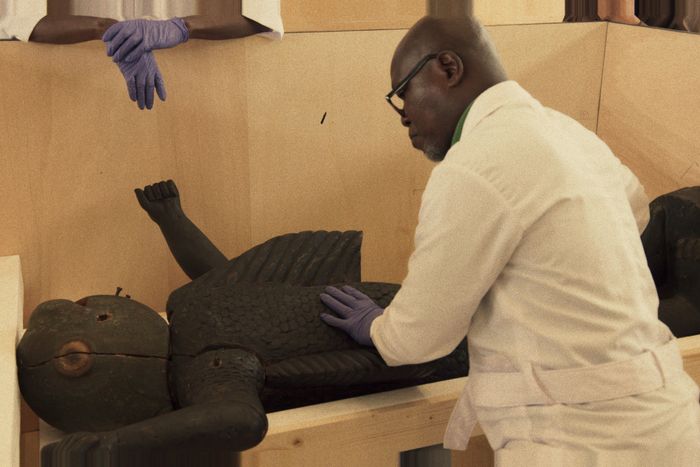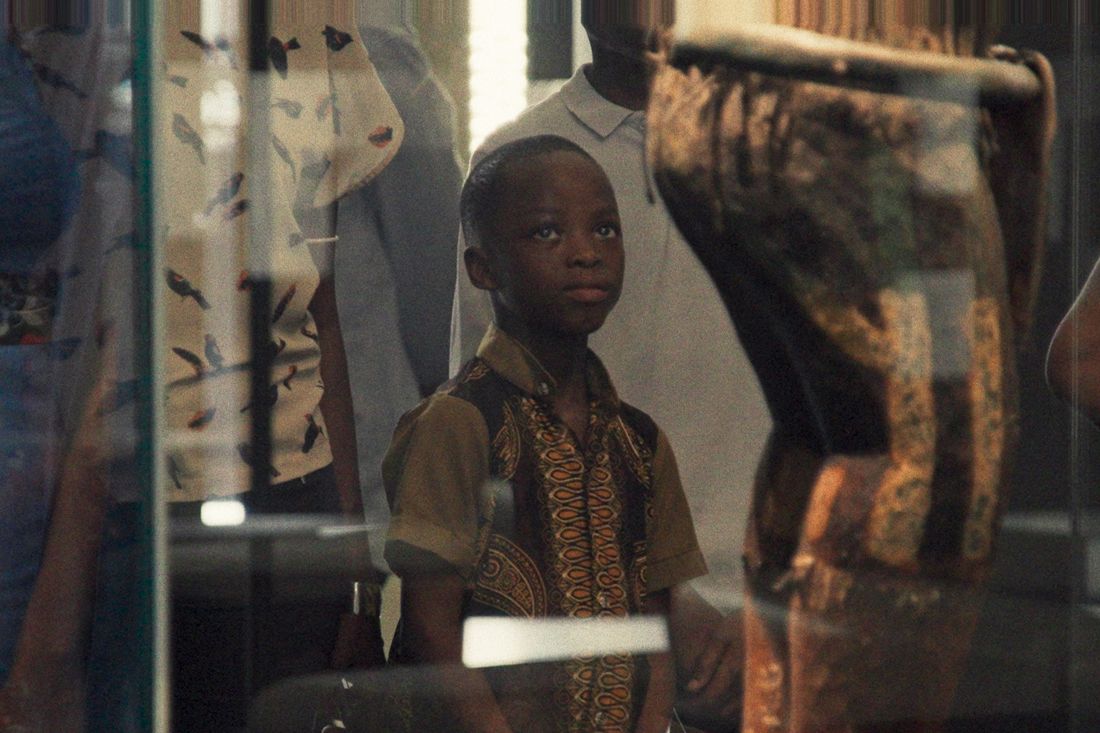
Mati Diop never thought she’d see it in her lifetime: 26 royal artifacts, pillaged by the French from the kingdom of Dahomey, finally repatriated from Paris to present-day Benin over a century later. Before President Emmanuel Macron announced the return of these works in 2018, the French Senegalese actress and director was planning to write a fictional film about restitution. She had already envisioned it: An African mask would recount, in voice-over, the tale of his pillaging and eventual return to his homeland, which she imagined in the future. It would be his turn to speak.
What Diop made instead has both the weight of something true and the magic of something imagined. The powerfully diminutive 68-minute Dahomey, which won the top prize at the Berlinale earlier this year, threads documentary with fantasy to capture these works’ rich and complex return back to Benin. It opens in the cold basement of Paris’s Musée du Quai Branly, where statues are lowered into coffinlike wooden crates. Interwoven throughout: a voice-over from the statue that represents Ghezo, the king of Dahomey from 1818 to 1858, speaking for “the 26” over a black screen. “I am torn between the fear of no one recognizing me and not recognizing anything,” he says of his homeland, now foreign after so many years of confinement in Europe. Once in Benin, the movie opens up. We see the Beninese visit the treasures for the first time and university students debate what this first, small restitution means for them, their words echoing through the streets of Cotonou. (According to one study they cite, 90 percent of African culture and artifacts are still held in French museums.)
“The term restitution could describe the heart of my work,” Diop told me in French. The filmmaker’s Dakar-set debut feature Atlantics (the 2019 Grand Prix winner at Cannes) countered the European media’s impersonal focus on migrant death counts with an intimate ghost story told from the point of view of the women left behind. Beyond artifacts and artworks, Diop is interested in giving a voice back to young Africans, allowing them to wield their own stories. We met during the New York Film Festival to discuss how she got a crew together in just two weeks to film Dahomey, how the journey of these works relates to her personal history, and why she isn’t afraid of making political work.
You’ve already spoken a lot about Dahomey in screening rooms around the world, from Benin to Senegal to the American premiere in New York. What are you still learning about this film from speaking about it with viewers?
I have never questioned the limits of my medium more than during the last few years. For me, the political aspect of my work is fundamental, even central. That’s how I’ve chosen to use cinema. But is that enough today? When you really look at certain issues, you’re like, “Okay, we better all stop what we’re doing and become activists, actually, because otherwise we’ll never make it.”
This film revitalizes me because I’m realizing that it succeeded in achieving the function I wanted to give it: It sparks reflection, questions, and debate between people. I was enormously surprised to realize to what extent the audience felt the film made a lot of space for them. This space allows them to use their own intelligence, their own sensibility. And I think that the viewer is actually asking for more room within films, to be less hand-held. People have said “thank you” about Dahomey a lot more than “well done.”
As a filmmaker, I don’t feel like I’m sidestepping political issues. I found a meeting point between cinema and politics, and it really fulfills me because I couldn’t choose between one and the other.
And you’ve never had any fear about making political art? Because there are risks to that.
No, I am not afraid. I think that my films protect me insofar as they avoid the pitfalls of activism. While being very politically engaged, they question, they challenge, they provoke reflection, but they are not into shortcuts or polemics. It is not necessarily controversial.
And it’s true that I publicly supported Palestine onstage in Berlin, which was a quite tricky place to do that. But I think we must absolutely not give into fear. I am French, I am extremely privileged. If we, the ultra-privileged, started to freak out about making political comments … no, there’s no reason. Lots of other people take much bigger risks.
I’m wondering whether you also manage to avoid risks due to the form of this film, which is hybrid, mixing documentary with more fantastical elements. How did you find the form?
The form actually preceded the filming of Dahomey because I’d planned to dedicate a fictional film to the subject of restitution. When I heard in the news that 26 royal treasures were going to be repatriated, I already had this idea to film this return from the point of view of the works themselves, to experience it as an internal odyssey. And later, when I decided to make a film that would be longer than just the return, I immediately envisioned the debate: the university, the agora, this circular space where discussion circulates. I work a lot based on vision. Afterwards, you have to put together a whole production to obtain this initial vision.
Then I have time to really refine and refine layer by layer, through sound, through editing, through text. I really have the feeling of sculpting while editing — particularly the debate, which is really a six-hour block inside of which we were able to cut away, to bring out the essence of what seemed crucial to be expressed, heard, shared.
So you learned that these treasures were going to be repatriated, and then you had two weeks to begin filming. What did you do to capture this moment?
In the urgency of those two weeks, it’s mostly issues of production. How do we get such an important film off the ground without money? My co-producers, Les Films du Bal, and I understood that either the Benin government was going to lend us money, give us the go-ahead to film the works, or there would be no film. It’s pretty delicate because no film wants to be so closely associated with a government. But at the same time, it’s about restitution, it’s very political. So we called upon the government, whose adviser to the minister of culture knew my work. I think they realized that it would be really beneficial for them to have a film about their restitution made by me. And so they accepted that I be the person to do it, on the condition that the movie remain strictly independent.
Within two weeks, we were able to get the government’s approval and financial support. I created my own production company in Dakar (Fanta Sy) to co-produce this movie because I thought it was important for the film to be carried out by two companies, one French, one African, and that I take on a role in production as well. Bringing a team together was all the more important because I was still stuck on another set and couldn’t make it to the landing of the works in Cotonou. So to entrust that very, very important sequence of the movie to my team was interesting because I transmitted a lot of stuff to them. Above all, I told them that it had to always, always, always be cinema. We weren’t making a documentary or a report; we were making a film, and that always had to be the ambition. If the first shots are not good, there’s no film. The cinematographer, Joséphine Drouin-Viallard, took some magnificent shots of the arrival of the treasures at the airport — that’s how I’d dreamed them.
What other instructions did you give her?
That we really had to feel like we were experiencing this journey, this return, from the point of view of the works. To never lose sight of the fact that the film was being told by them.
The film opens in Paris, on the bank of the Seine. These are some of the only scenes in your work that take place in France.
Yeah, apart from a music video for Bonnie Banane that I shot at the Eiffel Tower. I also filmed Paris from my room in a film called In My Room.
I felt a need to free myself from a western culture that was really starting to take up all of the space. It was a genuine shift for me, one that I made in a fairly solitary way. It wasn’t within a collective or movement of thought. At the time, I was in a very white environment, frankly; my friends in Paris were white. I acted in a film by Claire Denis called 35 Shots of Rum, where I played the daughter of a Black man. There was the fact of being presented to the world through that character and the ten-year anniversary of my uncle Djibril’s death. All of that encouraged me to question the relationship I had with my African origins. There was something that I had to come and reclaim.
Where did the desire to decenter France in your work come from?
It comes from a need to overcome that centrality, that universalist and colonial heritage that considers France the center of gravity of thought and aesthetics. I immersed myself in an artistic environment in Paris. From age 15 to 26, the majority of my references were western. And that’s not necessarily a problem. It’s just that at a certain point, there came an awareness of the hegemonic dimension of that culture — and at a time when it wasn’t really questioned, at the beginning of the 2000s. What made me want to make movies were films like Kids by Larry Clark and Virgin Suicides by Sofia Coppola, films by Cassavetes and Claire Denis, and that’s all very well. There was this sort of awakening where I was like, “Okay, I’m not only French. I’m also Senegalese. I’m also Black. I’m also Djibril Diop Mambéty’s niece.”
I also started to really feel to what extent so-called African cinema was in the midst of disappearing. I had a hard time seeing so little representation from the African continent by Africans themselves. The only representations they were allowed were through mass media or images of migrants on canoes collapsing in front of European fortresses. Those were really the images of my country, Senegal, that were broadcast. I realized that my uncle’s work had done something absolutely politically unique and allowed us to revolutionize a lot in terms of the imagination, and that it was important to begin my filmmaking where he’d left off. But with my language, my sensibility, the tools of my era, I felt very free to be in continuity with his work and at the same time to invent something else.
What connection did you have with Senegal while growing up in Paris?
I was lucky enough to be in touch with my African family very early. My mother is French; it’s my father who’s Senegalese. I think the two of them took me there to introduce me to my father’s family. But afterwards, it was my mother who continued to take me on her own as a way to really embrace her child’s dual culture. There are many mixed-race children who don’t get that chance.
That’s really lucky.
It is. My mother, who is white and French, did the work of transmission that my father didn’t. As a result, this kind of belonging that I have always felt toward Senegal allowed me to return there as an adult without any complexes. Because I was close with my family, because I felt at home there. And the fact of being Djibril Diop Mambéty’s niece — even though I never met him because he died when I was a teenager and transmitted nothing to me directly — I admit that it also gave me a form of legitimacy. Not because I’m his niece, but because I chose to inherit his cinema, just as someone who isn’t related to him might. It gave me the strength to free myself from questions of legitimacy.
In what ways does the story of the return of these works resemble your own story?
I identified with them immediately. The term restitution could describe the heart of my work ever since I chose to begin it in Dakar with Atlantiques, a short that I filmed in 2008. In that film, a young man who emigrated from Dakar to Europe who’s just been violently repatriated by Spain tells his two best friends, including my cousin, the story of his journey across the sea. For me, it was a way to restore the speech of these migrants, to give a voice back to those who lived it. It felt super important to me to dedicate a film to someone who is capable of telling his own story in the first person, to put him back into the center of his own reality. That is a gesture of restitution for me.
The works in Dahomey suffered a number of events tied to colonial history. Their pillaging, then everything that the colonial gaze dumped on these works, the ethnocentric gaze, the commercial element too. They were distorted and then redefined by an outside gaze. So when these works return to their home country, they are from several places at once, as much from where they were pillaged as from where they spent over a century. The questions they might express — “Am I going to recognize the country I left, will I be recognized?” — those are all questions that may have crossed my mind as a mixed person. You’re the fruit of such complex history and, based on where you are — which is to say either in the former colonial power or the formerly colonized country — you represent and incarnate different realities. It was important for me to highlight the multidimensional aspect of their experience.
And giving them a voice also, which in Dahomey you do through the statue of Ghezo.
Ghezo is a vehicle that I’m using to speak about a much larger community of souls than the statue. In fact, it’s a whole community of Black souls from the time of the slave trade up to today’s young diaspora. It’s the soul of an entire people that’s evoked through this voice.
The sound of the voice is really distinctive. How did you construct this sound?
First of all, it’s a language.
Old Fon.
Old Fon. Ghezo’s voiceover was co-written with Makenzy Orcel, a Haitian writer. The descendants of Haitians were deported during the slave trade from the gulf of Benin. So for me, it was super important that the person who wrote the text carry within him in some way the traces of this history, visible or invisible.
I brought in Nicolas Becker, a sound designer and artist with whom I really wanted to work. This voice, beyond words, beyond Fon, is a texture. Nicolas and I went to Benin to make a recording of three different voices, a woman and two men. It was his idea to mix different voices. I wanted something robotic, futuristic, something that completely broke with the folkloric image that westerners have made of our traditions and our ancestors, this sort of sleepy wisdom of the African storyteller by the fire. Cinema must bring out new imaginations about our histories. It’s also important to make our stories and our ancestors desirable again, inspiring …
Intimidating.
Yes, even threatening.
The debate between students from a university near Cotonou is one of the most vibrant moments in the film. How did you create the conditions for this debate to take place?
If young people aren’t at the heart of restitution, in my opinion, you completely miss the point. Giving this debate the heart of the film was really an important statement. The question of restitution must be raised from the African continent, starting with young Africans. They are the people to whom restitution is destined. These young people — who were deprived of their cultural heritage, of their cultural goods — who nevertheless represent 70 percent of the continent managed to build a political consciousness for themselves without those material traces. So the film had to return the debate to these young people. Outside of filmmaking, it’s a political gesture.
In terms of directing, I really proceeded as I would have with a fiction. I held auditions, I very carefully chose young people from different disciplines — art history, history, finance, political science — based on their ability to articulate themselves, on what they said that interested me that we’d never heard. I also made sure that they had different opinions. I chose the location, which is a pretty cinematic place because it’s open, a real agora. But once we got them all together and started filming, it’s them, their words, their ideas based on very precise questions that I asked through the moderator.
The sequence, for me, ultimately has something utopian about it because it’s true and untrue. It’s true because they are speaking and saying what they really think. But it’s untrue because if the film had never organized it, it wouldn’t have happened. I think that tells us that cinema has this ability to create a reality that might not exist yet, to actually bring it to life.
The film came out in France several weeks ago. I am curious what the reception was like there and how you experienced it.
I was a little apprehensive because the film carries so many heavy subjects, and it wasn’t easy to carry all that on my shoulders. I feel like it generated a little shock wave, that something really happened. We got the cover of Libération, a lot of feedback from viewers on social media. We’ve all inherited colonial trauma, and I think this film has a healing aspect. It really invites you to experience this history, not at all in a black-and-white way — the bad guys on one side, the oppressed on the other — but in a space that’s much more complex and ambiguous and leaves each person room to examine the vestiges of the past within the present. I feel like the film doesn’t belong to me anymore. It really allows the viewer to make it their own.
This conversation was translated, edited, and condensed for clarity.


